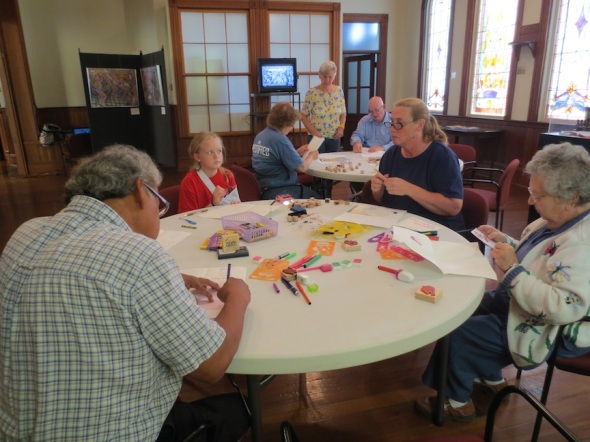Let’s Make a Quarto: Crafting Books by Hand
Modern book making is a highly mechanized business. In the most common case, sheets of paper are piled together into a block, the spine edge might be sanded or notched, glue is applied, and a cover attached. There is little handcraft in the process, and when you consider the adage, “Good, cheap, and fast—you get to choose two,” modern glue binding is mostly cheap and fast.
On April 25, some Tifton-Tift County library patrons got an opportunity to see how book production might have occurred in 1611. Jerry Walker, a retired educator with a lifelong interest in the arts and a highly skilled crafter, led a workshop that we titled “Let’s Make a Quarto: a type of book made in the Renaissance era.” The workshop was held in the museum that houses the Manifold Greatness exhibit, so anyone who had not seen the exhibit got the opportunity to see it then, as well as make their own little book.
The basic idea behind a quarto is that a large sheet of paper is folded to make four smaller pages (hence the “quarto”). It was a very common way of producing books during the time of the King James Bible, allowing eight pages to be printed with only two trips through the press and using only one sheet of paper.
Some of our participants found out the hard way what this folding does to the orientation and the numbering of the pages. We suggested folding the paper, marking the page numbers and the bottom of the pages with a pencil, and then unfolding the page before decorating the pages with a story, stamps, stencils, pictures, and other decorations. (There was no glitter—we had used it all at the Renaissance Faire.) We got some great little stories and pictures. Some of them were upside down and in the wrong order, but we decided that you learn from mistakes, too.
Our amateur bookbinders learned how pages were made into “gathers” and then sewn together to make a finished book, ready to be bound. On the 16th of May, Tracy Iwaskow will be coming from Emory University’s Theology Library and will be bringing some selections from their special collections. Many of the participants are looking forward to seeing examples of the professional bookbinder’s craft.
Vickie Horst is the Manager of Tifton-Tift County Public Library in Tifton, Georgia.
You can find additional information about Making a Quarto, including a video, on the Manifold Greatness website.






